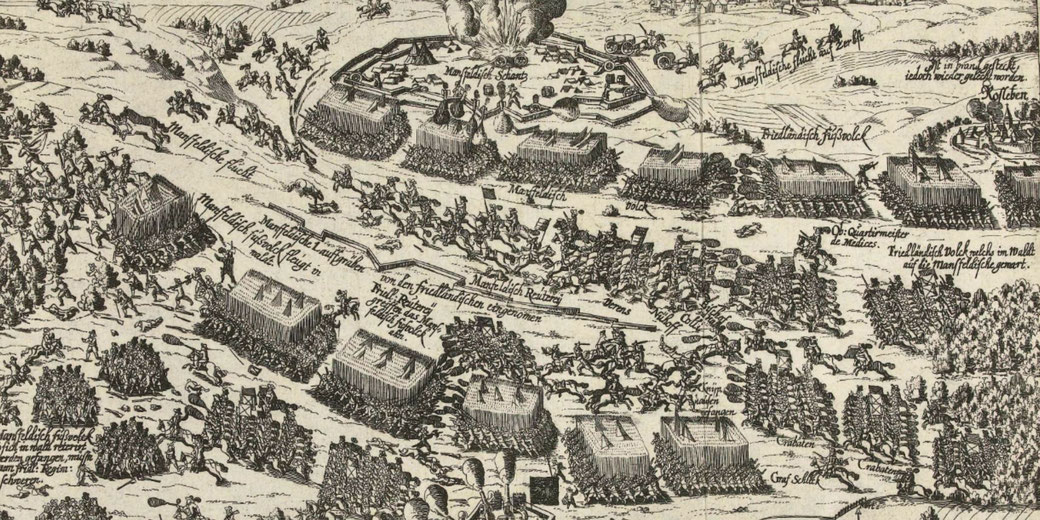How the bloody clash at Dessau Bridge became a turning point in the Thirty Years' War

In 1626, the German town of Dessau was shattered by the sound of cannon fire at a nearby ridge. This began one of the bloodiest confrontations of the Thirty Years' War.
This broader conflict had begun in 1618, which pitted Protestant and Catholic states against each other. On that fateful day in 1626, on one side of the bridge stood the Imperial forces commanded by Albrecht von Wallenstein, who were determined to stop the approaching Protestant army under Ernst von Mansfeld from crossing.
What was about to take place would have significant impacts on the entire course of the religious conflict breaking out across Europe.
Who fought in the battle?
The forces that were about to meet at Dessau Bridge were led by two prominent commanders, each with a formidable reputation by this point in the conflict.
Ernst von Mansfeld commanded the Protestant army, and he had with him around 12,000 soldiers. They included a mix of German, Dutch, and English mercenaries, which was an experienced fighting force.
In addition to infantry, Mansfeld's army boasted a significant cavalry contingent. Mansfeld hoped that his numerical superiority would overpower the Imperial defenses and seize control of the strategic bridge.
On the opposing side, Albrecht von Wallenstein led the Imperial forces. Wallenstein's force comprised approximately 10,000 men, including seasoned infantry and a strong artillery division.
The strategic importance of the bridge
The unassuming Dessau Bridge held surprising strategic importance over the Elbe River during the war. The marshy areas and riverbanks around it meant that it was a crucial crossing point for military forces.
Controlling this bridge meant securing a vital route for the movement of troops and supplies. In addition, the bridge allowed for the rapid deployment of reinforcements.
For both the Protestant and Imperial forces, holding this bridge could determine the success of their campaigns in the region.
Mansfeld aimed to quickly seize the bridge to gain a significant advantage over Wallenstein's forces. He knew that if he could capture control of the Dessau Bridge, it would enable his army to threaten key Habsburg territories, such as the nearby important cities like Magdeburg and Leipzig.
On the other side, Wallenstein recognized the bridge's value and fortified his defenses accordingly.
How did each side prepare?
In March, Ernst von Mansfeld advanced his army towards Dessau. As Mansfeld approached, Wallenstein recognized the need to fortify his positions.
By mid-April, he had strengthened the defenses around the bridge. To bolster his forces, Wallenstein called for reinforcements from nearby garrisons.
Wallenstein then fortified his positions around the bridge and placed his artillery in strategic locations along the banks.
Positioned on elevated ground, the cannons had a clear line of fire on the approaching enemy.
On April 25, skirmishes erupted between the two armies. Mansfeld attempted to probe Wallenstein's defenses, looking for weaknesses to exploit.
In response, Wallenstein adjusted his positions, ensuring his troops were well-prepared for the anticipated assault.
What happened at Dessau Bridge?
On April 30, 1626, the battle began with an exchange of artillery fire. Wallenstein's forces, who were entrenched behind its fortifications unleashed its barrage of cannon fire at Mansfeld's advancing troops.
Undeterred, Mansfeld ordered his infantry to advance across the open ground, hoping to reach the bridge, supported by cavalry charges aimed at breaking the Imperial lines.
To counter this, Wallenstein deployed his own cavalry which engaged them in fierce skirmishes along the flanks. The Imperial forces held their ground, thanks to their fortified positions and superior artillery.
These defensive measures inflicted heavy casualties on Mansfeld's forces, slowing their advance.
As the day wore on, Mansfeld attempted a daring flanking maneuver. He sent a contingent of troops to cross the Elbe River upstream.
By doing this, he hoped to attack Wallenstein's forces from the rear and create chaos along the enemy lines. However, Wallenstein anticipated this move and had positioned reserves to counter the attack.
Consequently, the flanking force faced stiff resistance and failed to achieve its objective.
Late in the afternoon, Mansfeld launched a final, desperate assault on the bridge itself. His forces, exhausted and depleted, surged forward in a last bid to break through.
This is where Wallenstein’s reserve units became invaluable. Held back from the initial engagement, they now provided a fresh and organized force which reinforced weak points in his lines and countered Mansfeld's final assault.
With their last hopes dashed and losses mounting, the Protestant forces began to retreat.
The key outcomes of the battle
The Battle of Dessau Bridge had concluded with a decisive Imperial victory. Wallenstein's forces had successfully defended the bridge and repelled Mansfeld's aggressive assaults.
The Protestant army suffered significant casualties, with estimates suggesting around 4,000 men were killed or wounded.
In the immediate aftermath, the impact of the battle rippled through the surrounding territories. Wallenstein's victory bolstered Imperial morale and demonstrated their ability to withstand Protestant advances.
To further capitalize on this success, Wallenstein pursued Mansfeld's retreating forces and maintained pressure on the already demoralized Protestant troops.
Mansfeld's retreat was an important turning point for the Protestant alliance. With his forces diminished, the Protestant army's ability to challenge Imperial dominance significantly declined.
The Habsburgs, buoyed by their success at Dessau, leveraged this victory to reinforce their dominance within the Holy Roman Empire.
What do you need help with?
Download ready-to-use digital learning resources
Copyright © History Skills 2014-2025.
Contact via email
With the exception of links to external sites, some historical sources and extracts from specific publications, all content on this website is copyrighted by History Skills. This content may not be copied, republished or redistributed without written permission from the website creator. Please use the Contact page to obtain relevant permission.





